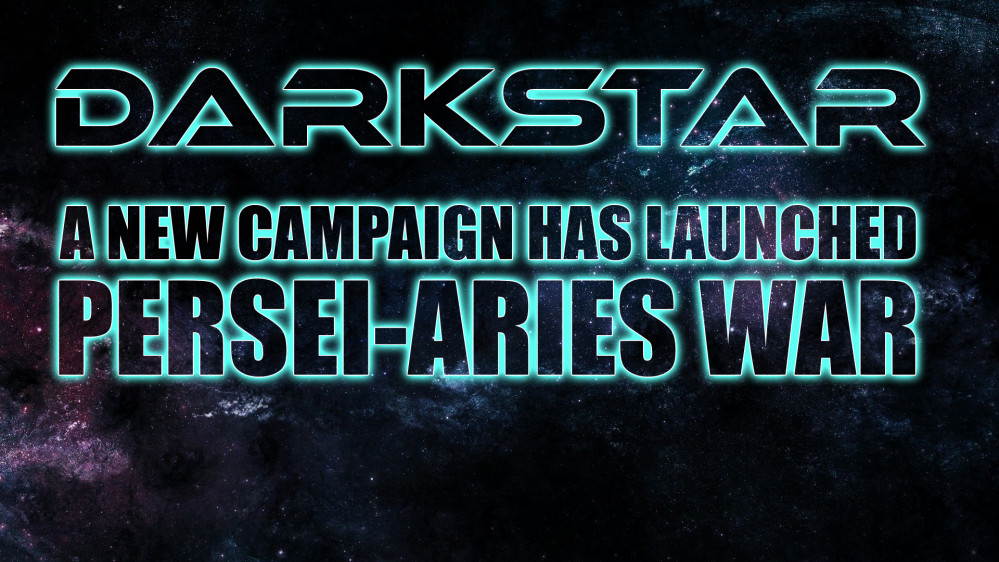
Persei-Aries War Resumes
Rasmus vs. Muakhah - Raid at KV323
FROM: UNITED NATIONS REGIONAL COLONIAL CENTER
03:10 SOL GMT, 16 JUNE 2521
BREAKAUTH: 181072.18J
CLEARANCE: SECRET (NATIONAL)
**UNITED NATIONS COMMUNIQUE**
Even as the ashes cool in the wake of the Third Battle of Hawking’s Star, and the shockwaves of that aftermath continue to ripple through the spinward star systems of the Hercules Rim, new battles are igniting along elsewhere in this ongoing war. Reports are now coming in of an action at KV323, a tiny Mercury-analog dwarf planet orbiting extremely close to the parent star of the 72 Hercules system. The 72 Hercules system is the home of the Russian Krasnaya Nadhezda (Red Hope) colonies, mainstay of the Holy Russian Empire in the Hercules Rim.
Raided repeatedly by the British and Japanese at the outset of this war, Krasnaya Nadhezda has since enjoyed a long stretch of calm in more recent months once the Americans started to threaten British holdings at Hawking’s Star (HR6806). But constant fighting at the Hawking’s Star colonies and the Redemption UN Mandate (99 Hercules) has stretched Russian naval forces across dozens of light years, not to mention divide the Duma’s support of this war and test the patience of the Tzar Aleksandr IX.
Choosing their moment, the Arab League, now firmly established at their new “Khaizan’s Haven” colonies in 14 Hercules, has apparently decided to bring the war back to Krasnaya Nadhezda. Swift, fast, and stealthy, the Al Fihri Battlegroup, under the flag of Captain Rashid al-Maghrebi, has been dispatched to penetrate the 72 Hercules system. strike targets of opportunity, and destabilize the Holy Russian Navy as much as possible.
Strategically, the Arab League hopes to capitalize on recent strain between the United States and the Holy Russian Empire in the wake of their defeat at Third Hawking’s Star. If the League can cause enough damage at Krasnaya Nadhezda, the Russians may demand more help from the Americans, just as the Americans demanded help from the Russians at Hawking’s Star. If the Americans help, that weakens them against the British. If the Americans don’t send help, the “Coalition of Eagles” between the Americans and Russians may well destabilize to the point of collapse.
Operationally, the League hopes to capitalize on the wide-spread, scattered deployments of the Russian Navy. Hawking’s Star is 24 light-years away, almost a month’s travel for a battlefleet of any size, and once the Russians arrived there they took heavy losses … twice. Although technically a Russo-American victory, the recent battle of Kayashenko 4 also diverted Russian naval assets 12 light-years away, defending another Russian colony world that again cost the Russian Navy dearly.
Tactically, the League has taken an unusual approach for the battlegroup’s mission. Typically, raiders set a high Darkstar wave toward the target system, stopping perhaps 500 AU outside the system’s outermost planets or debris belts. Then a new Darkstar wave is set, much slower, much more accurate, virtually impossible to detect. Perhaps moving only five times the speed of light, they “crawl” into the system and drop back into normal space in the eclipse shadow of a gas giant or just short of an asteroid belt.
Here, however, the League is trying an “inside out” approach. Rather than relying on sheer distance and the scale of empty space to hide them, the Al Fihri battlegroup is hoping to hide their approach amidst the deafening electromagnetic volcano that is the parent star of the system. A Darkstar wave set this close to the powerful gravity fields of a star, not to mention the solar wind and coronal mass ejections, is dangerous to say the least. But detecting enemy ships on a slow approach through such a firestorm is all but impossible.
The Al Fihri and her escorts manage to creep into the very heart of the Russian system. The 72 Hercules star is a G0V yellow main sequence star, perhaps 15% larger than Sol. Little more than a semi-molten ball of nickel-iron and rock, the tiny dwarf planet of KV323 lies in a blow-torched, tidally-locked orbit just 20 million kilometers from 72 Hercules, just over one-third the distance that Mercury orbits the Sun. It’s in the shadow of KV323 that the Al Fihri has been lurking, waiting for her aerospace group to find a suitable first target.
But the Russians catch a break. Detecting some of Al Fihri’s scouts and extrapolating their telemetry back to their base ship, they find the Arab League force and send two Slava class heavy cruisers to destroy them. They are only hounds, however, driving the Al Farir and her escorts around KV323 to the daylight side of the dwarf planet, where a smaller, faster Russian battlegroup … the hunters … are already in a parabolic slingshot around KV323 to intercept.
Holy Russian Empire: Rasmus (Oriskany with one ship)
Arab League: Muakhah (Oriskany with one ship)
222 points per side
RAID victory rules
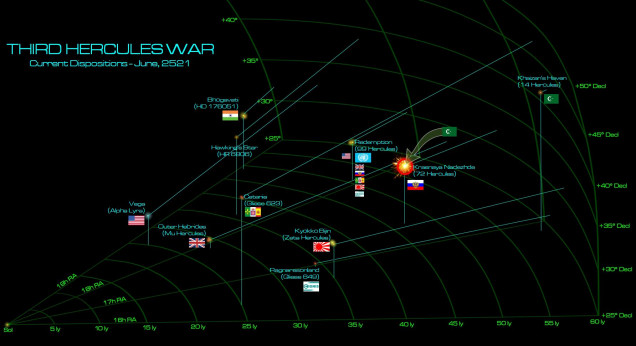 Current disposition on the Third Hercules War. With the Americans and Russians tied down in a grueling but ultimately futile effort in the Hawking’s Star colonies, the Arab League hopes for a successful incursion against a distracted, frustrated, and badly-dispersed Russian Navy at 72 Hercules (Krasnaya Nadhezda - “Red Hope”).
Current disposition on the Third Hercules War. With the Americans and Russians tied down in a grueling but ultimately futile effort in the Hawking’s Star colonies, the Arab League hopes for a successful incursion against a distracted, frustrated, and badly-dispersed Russian Navy at 72 Hercules (Krasnaya Nadhezda - “Red Hope”).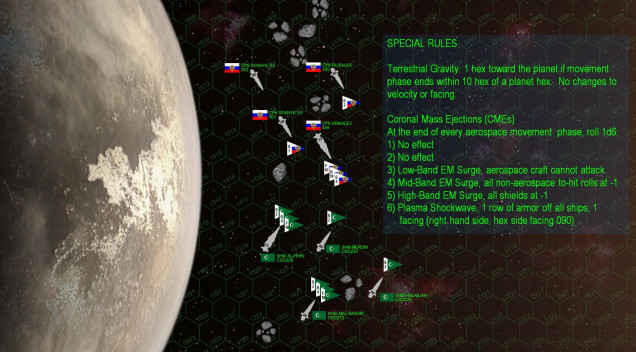 The matchup. For the League we have three ships of Muakhah’s “Al Fihri” Battlegroup. These include the Al Fihri herself (Almanzor-class light hybrid cruiser), the Basra-class destroyers Mersin and Halabjah (attached from Battlegroup Shalazar), and the Khalifa-class light carrier Abu Bashir. The Russians have Rasmus’ light fleet carrier CPK Krikalev (carrying slightly more fighters and bombers than the Abu Bashir and Al Fihri combined) and two escorting Sovnya-class destroyers. A third Sovnya-class destroyer is deployed, the CPK Rusalka (attached from Task Force Lazarev). In all, the Russian destroyers outnumber and outgun the League destroyers, while the aerospace groups are ROUGHLY equal. However, the guns of the Al Fihri may tip the balance, as that Russian “light cruiser” (actually a light fleet carrier) carries no guns at all, only fighters, bombers, and a relatively small complement of outdated P-500 Class III torpedoes. ALSO NOTE – the special rules for combat this close to main sequence star. The electromagnetic turbulence this close to a G0V main sequence star is literally off the charts, especially when the star is in a more turbulent period. Depending on the dice roll each turn, the star’s intense coronal mass ejection can effect aerospace craft, warship sensors, warship shields, or a full-blown plasma shockwave of charged particles can burn a layer of armor clean off one facing of every ship on the board.
The matchup. For the League we have three ships of Muakhah’s “Al Fihri” Battlegroup. These include the Al Fihri herself (Almanzor-class light hybrid cruiser), the Basra-class destroyers Mersin and Halabjah (attached from Battlegroup Shalazar), and the Khalifa-class light carrier Abu Bashir. The Russians have Rasmus’ light fleet carrier CPK Krikalev (carrying slightly more fighters and bombers than the Abu Bashir and Al Fihri combined) and two escorting Sovnya-class destroyers. A third Sovnya-class destroyer is deployed, the CPK Rusalka (attached from Task Force Lazarev). In all, the Russian destroyers outnumber and outgun the League destroyers, while the aerospace groups are ROUGHLY equal. However, the guns of the Al Fihri may tip the balance, as that Russian “light cruiser” (actually a light fleet carrier) carries no guns at all, only fighters, bombers, and a relatively small complement of outdated P-500 Class III torpedoes. ALSO NOTE – the special rules for combat this close to main sequence star. The electromagnetic turbulence this close to a G0V main sequence star is literally off the charts, especially when the star is in a more turbulent period. Depending on the dice roll each turn, the star’s intense coronal mass ejection can effect aerospace craft, warship sensors, warship shields, or a full-blown plasma shockwave of charged particles can burn a layer of armor clean off one facing of every ship on the board. 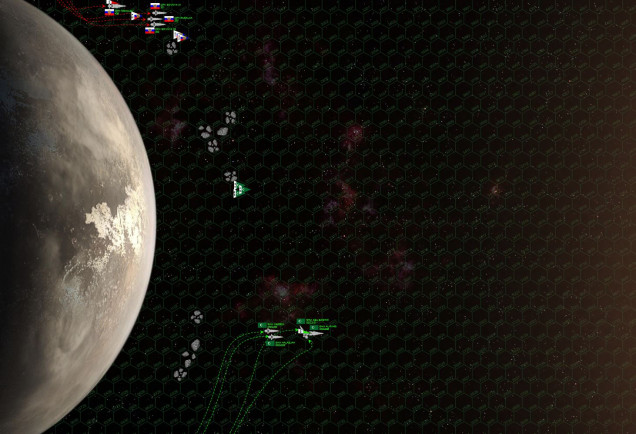 The two fleets make their approach. The Russian carrier flagship stays well clear of any potential battlezones, instead launching her fighters and sending her three destroyer escorts out to engage the League at close range. Initially the Russian destroyers are completely blind, well-hidden behind lunar debris in low orbit over KV323. Not that it matters much, the star is currently streaming out mid-frequency EM turbulence, and everyone is at -1 to hit. Still, the Al-Fihri and her escorts have the Krikalev broadsided. The range is almost 4200 kilometers, but even at this distance, even through the EM storm, the League scores the first hits, damaging the Russian flagship along her starboard bow.
The two fleets make their approach. The Russian carrier flagship stays well clear of any potential battlezones, instead launching her fighters and sending her three destroyer escorts out to engage the League at close range. Initially the Russian destroyers are completely blind, well-hidden behind lunar debris in low orbit over KV323. Not that it matters much, the star is currently streaming out mid-frequency EM turbulence, and everyone is at -1 to hit. Still, the Al-Fihri and her escorts have the Krikalev broadsided. The range is almost 4200 kilometers, but even at this distance, even through the EM storm, the League scores the first hits, damaging the Russian flagship along her starboard bow.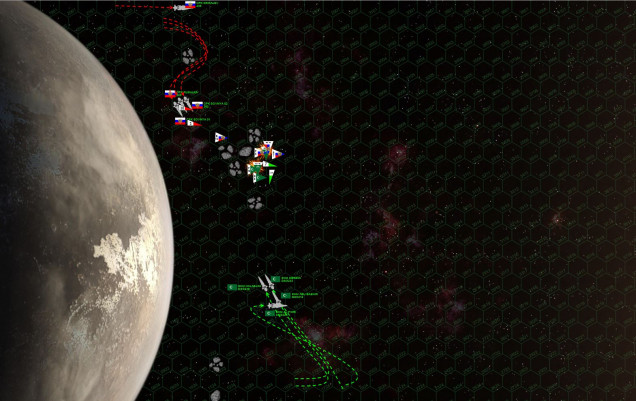 Both sides take the risky choice of cutting INSIDE the lunar debris belts over KV323 as the ships close the range to engage. But Darkstar is a subtle game, and two important factors are at play here. One, the Russians seem to have the “gravity gauge,” cutting closer to the planet and turning AWAY from KV323 to engage the League, who in contrast must turn TOWARD the planet to engage the Russians in turn. This will have fateful consequences later. Also, the League’s bombers have moved much too close to the Russians and outdistanced the mass drivers on their own warships. In short, they have no point defense cover as the Russian fighters (Mikoyan-Guyevich MiG-103 “Tunguska” class) swarm over them. The Arab League “Mylekinir” (Fire Angel) fighters sweep in to respond, and wreak heavy damage on the Russian MiGs. But it’s too late to save any of the League’s bombers. Some Russian MiGs and scouts are even able to fight back against the League’s Fire Angels. Russian bombers, meanwhile, remain at a safe distance back, comfortably under mass driver cover of their three destroyers ... who also just launched a combined 30 P-500 “Plamya” (Flame) torpedoes from their forward spreads.
Both sides take the risky choice of cutting INSIDE the lunar debris belts over KV323 as the ships close the range to engage. But Darkstar is a subtle game, and two important factors are at play here. One, the Russians seem to have the “gravity gauge,” cutting closer to the planet and turning AWAY from KV323 to engage the League, who in contrast must turn TOWARD the planet to engage the Russians in turn. This will have fateful consequences later. Also, the League’s bombers have moved much too close to the Russians and outdistanced the mass drivers on their own warships. In short, they have no point defense cover as the Russian fighters (Mikoyan-Guyevich MiG-103 “Tunguska” class) swarm over them. The Arab League “Mylekinir” (Fire Angel) fighters sweep in to respond, and wreak heavy damage on the Russian MiGs. But it’s too late to save any of the League’s bombers. Some Russian MiGs and scouts are even able to fight back against the League’s Fire Angels. Russian bombers, meanwhile, remain at a safe distance back, comfortably under mass driver cover of their three destroyers ... who also just launched a combined 30 P-500 “Plamya” (Flame) torpedoes from their forward spreads. 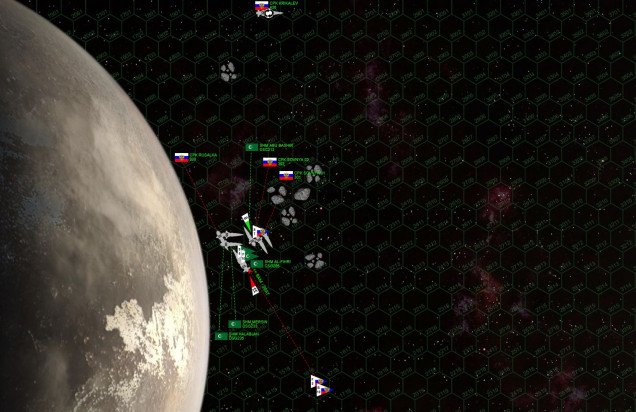 Things ... get extremely hectic here. As the League destroyers close to engage, the Russian destroyer Rusalka accelerates, cuts a shallow S-turn RIGHT AT the League destroyers, and slashes a broadside right across BOTH their sterns at point blank range. The Al Fihri rushes in to help, even though the ship’s AI warns that if she loses power at this vector, at this speed, KV323’s gravity will pull her down to a fiery crash on the planet’s surface. Russian torpedoes swarm around Al Fihri to attack her stern, followed by a hail of aerospace torpedoes launched from their Tupolev Tu-97 “Zvesburya” (Star Storm) bombers and surviving MiGs. League fighters give up the idea of a missile attack against the Russian destroyers – probably a good idea but with all their bombers already gone. Instead they return to the Al FIhri to shoot down incoming Russian torpedoes. Meanwhile, a torpedo spread from the Abu Bashir tries to hit the two Russian Sovnya-class destroyers, but these are all shot down. Meanwhile, Abu Bashir herself rushes up to provide vain mass driver support to the League flagship, and the other two Russian destroyers race up to put a point-blank broadside right into her starboard quarter.
Things ... get extremely hectic here. As the League destroyers close to engage, the Russian destroyer Rusalka accelerates, cuts a shallow S-turn RIGHT AT the League destroyers, and slashes a broadside right across BOTH their sterns at point blank range. The Al Fihri rushes in to help, even though the ship’s AI warns that if she loses power at this vector, at this speed, KV323’s gravity will pull her down to a fiery crash on the planet’s surface. Russian torpedoes swarm around Al Fihri to attack her stern, followed by a hail of aerospace torpedoes launched from their Tupolev Tu-97 “Zvesburya” (Star Storm) bombers and surviving MiGs. League fighters give up the idea of a missile attack against the Russian destroyers – probably a good idea but with all their bombers already gone. Instead they return to the Al FIhri to shoot down incoming Russian torpedoes. Meanwhile, a torpedo spread from the Abu Bashir tries to hit the two Russian Sovnya-class destroyers, but these are all shot down. Meanwhile, Abu Bashir herself rushes up to provide vain mass driver support to the League flagship, and the other two Russian destroyers race up to put a point-blank broadside right into her starboard quarter.  The Battle of KV323 is determined with horrific speed. As if so many ships at point-blank range weren’t bad enough, the 72 Hercules star emits a huge sheet of HIGH frequency EM radiation, taking down everyone’s shields by -1 this turn. This ... is gonna get BLOODY. First, the Mersin’s aft guns fire point-blank into the port bow of the CPK Rusalka. The Rusalka reels, but the her plasma projectors into broadside into the stern of the Mersin. Not only is the Mersin crippled, she actually EXPLODES in a cataclysmic fusion-powered blast. The Halabjah fires her after guns into the Rusalka at the same instant as the Rusalka fires her rail guns into the Halabjah’s stern. The Halabjah manages to burn her way into the Rusalka’s port bow in the same place the Mersin hit her just a moment before, striking the Rusalka’s bridge and knocking her out of the battle. But the Halabjah’s also in trouble, the Rusalka’s 7-gigawatt rail gun hits in her powerplant, plus the shockwave of the unfortunate Mersin, actually leave her crippled as well. The Al Fihri and Abu Bashir manage to shoot down most of the Russian aerospace torpedoes, and the Al Fihri’s broadside cripples the first Sovnya destroyer. But enough of the P-500s from the three destroyers hit her engineering section (as well as the two Sovnya destroyers hitting her port bow and setting off her forward magazine) to leave her crippled as well. Immediately the order is given to abandon ship since, try to the AI’s warning, the Al Fihri does NOT have escape velocity to clear KV323 on this trajectory. The second Sovnya, meanwhile, hammers the Abu Bashir, not managing to cripple her but definitely forcing her out of the battle. That second Sovnya, however, has also been damaged by Al Fihri, and a heartbeat later the blast wave from the Mersin’s explosion hits her, and actually cripples her as well. Indeed, the CPK Rusalka has thus crippled THREE warships in a single fire phase ... even if one of them was a fellow Russian ship. =*( Note that a handful of Russian scouts, League fighters and League scouts are also lost in this explosion.
The Battle of KV323 is determined with horrific speed. As if so many ships at point-blank range weren’t bad enough, the 72 Hercules star emits a huge sheet of HIGH frequency EM radiation, taking down everyone’s shields by -1 this turn. This ... is gonna get BLOODY. First, the Mersin’s aft guns fire point-blank into the port bow of the CPK Rusalka. The Rusalka reels, but the her plasma projectors into broadside into the stern of the Mersin. Not only is the Mersin crippled, she actually EXPLODES in a cataclysmic fusion-powered blast. The Halabjah fires her after guns into the Rusalka at the same instant as the Rusalka fires her rail guns into the Halabjah’s stern. The Halabjah manages to burn her way into the Rusalka’s port bow in the same place the Mersin hit her just a moment before, striking the Rusalka’s bridge and knocking her out of the battle. But the Halabjah’s also in trouble, the Rusalka’s 7-gigawatt rail gun hits in her powerplant, plus the shockwave of the unfortunate Mersin, actually leave her crippled as well. The Al Fihri and Abu Bashir manage to shoot down most of the Russian aerospace torpedoes, and the Al Fihri’s broadside cripples the first Sovnya destroyer. But enough of the P-500s from the three destroyers hit her engineering section (as well as the two Sovnya destroyers hitting her port bow and setting off her forward magazine) to leave her crippled as well. Immediately the order is given to abandon ship since, try to the AI’s warning, the Al Fihri does NOT have escape velocity to clear KV323 on this trajectory. The second Sovnya, meanwhile, hammers the Abu Bashir, not managing to cripple her but definitely forcing her out of the battle. That second Sovnya, however, has also been damaged by Al Fihri, and a heartbeat later the blast wave from the Mersin’s explosion hits her, and actually cripples her as well. Indeed, the CPK Rusalka has thus crippled THREE warships in a single fire phase ... even if one of them was a fellow Russian ship. =*( Note that a handful of Russian scouts, League fighters and League scouts are also lost in this explosion. 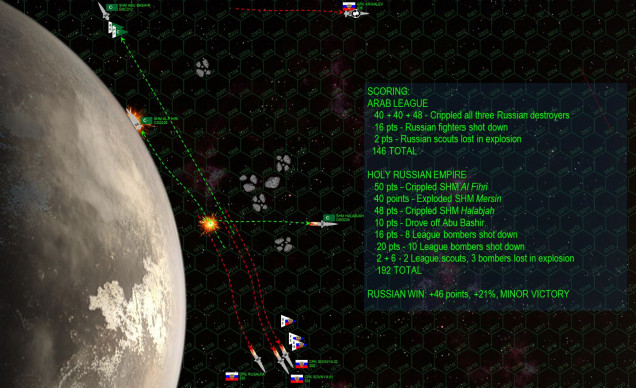 There are literally only two ships left ... the CPK Krikalev (rolled on her back to fire more torpedoes from her portside tubes) and the grievously-damaged Abu Bashir, which has already been forced for break off the action anyway. The crippled ships make their post-battle recovery rolls, some of them with Commander’s Luck points. Commander Alexander Kharichev aboard the CPK Rusalka escapes serious injury from the destruction of his bridge, he’ll also get his ship home in one piece, eventually. The Halabjah will also be recovered, but the Al Fihri is pulled down to the surface of the KV323 and vanishes in a spectacular explosion as she hits the charred dwarf planet at 18 kilometers per second. The captains of both the Al Fihri and the Mersin will live to fight another day, although again, some Commander’s Luck points had to be used.
There are literally only two ships left ... the CPK Krikalev (rolled on her back to fire more torpedoes from her portside tubes) and the grievously-damaged Abu Bashir, which has already been forced for break off the action anyway. The crippled ships make their post-battle recovery rolls, some of them with Commander’s Luck points. Commander Alexander Kharichev aboard the CPK Rusalka escapes serious injury from the destruction of his bridge, he’ll also get his ship home in one piece, eventually. The Halabjah will also be recovered, but the Al Fihri is pulled down to the surface of the KV323 and vanishes in a spectacular explosion as she hits the charred dwarf planet at 18 kilometers per second. The captains of both the Al Fihri and the Mersin will live to fight another day, although again, some Commander’s Luck points had to be used. 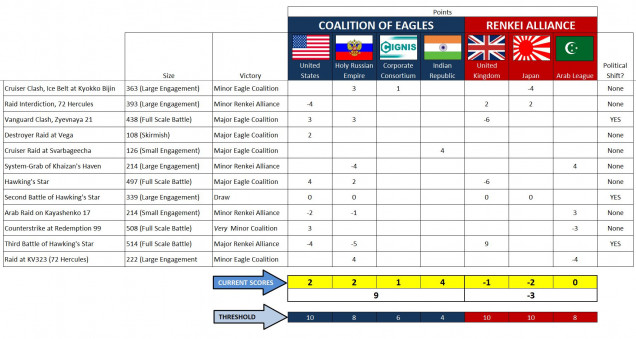 In overview, the Raid at KV323 is a sorely-needed victory for the Holy Russian Empire. Although three destroyers will spend months in dry dock, Arab League’s attempt to threaten 72 Hercules and destabilize the Coalition of Eagles has failed. Meanwhile, back-to-back defeats at Kayashenko 4 and KV323 has dispelled any illusions that the Arab League is in for an “easy” war here. There are now recriminations between several of their Star Caliphates, suggestions made that they should have taken the peace deal offered to them after their victory over the Americans at Kayashenko 17. Of course such options are long behind them now, the League has no choice but to knuckle down and WIN their part of this expanding and intensifying war across the Hercules Rim.
In overview, the Raid at KV323 is a sorely-needed victory for the Holy Russian Empire. Although three destroyers will spend months in dry dock, Arab League’s attempt to threaten 72 Hercules and destabilize the Coalition of Eagles has failed. Meanwhile, back-to-back defeats at Kayashenko 4 and KV323 has dispelled any illusions that the Arab League is in for an “easy” war here. There are now recriminations between several of their Star Caliphates, suggestions made that they should have taken the peace deal offered to them after their victory over the Americans at Kayashenko 17. Of course such options are long behind them now, the League has no choice but to knuckle down and WIN their part of this expanding and intensifying war across the Hercules Rim. 






























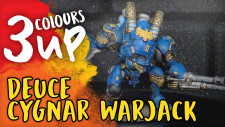




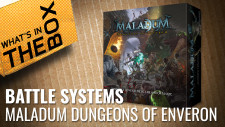





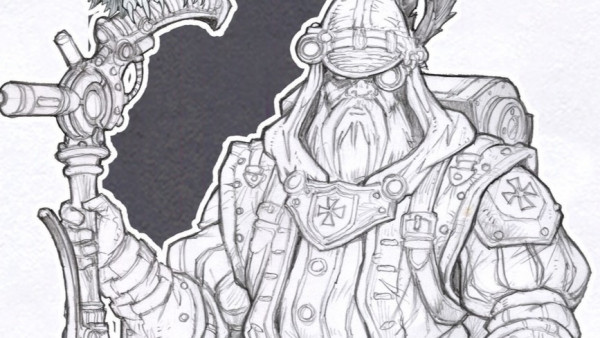



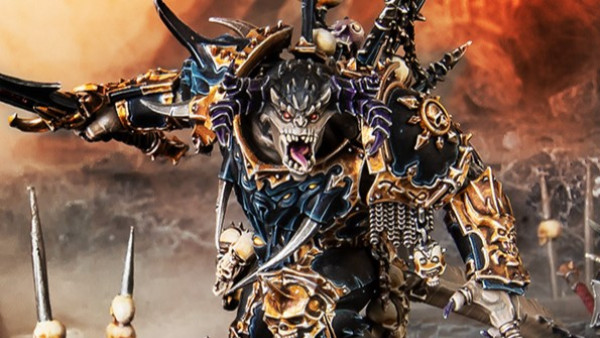
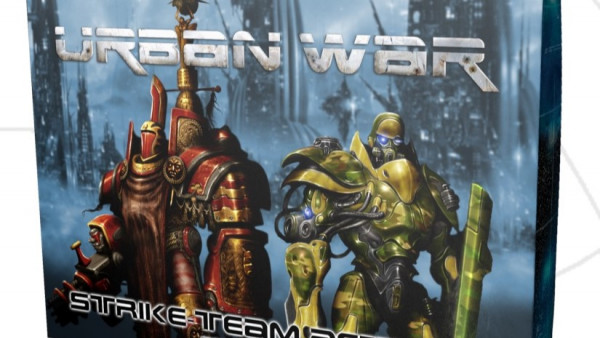
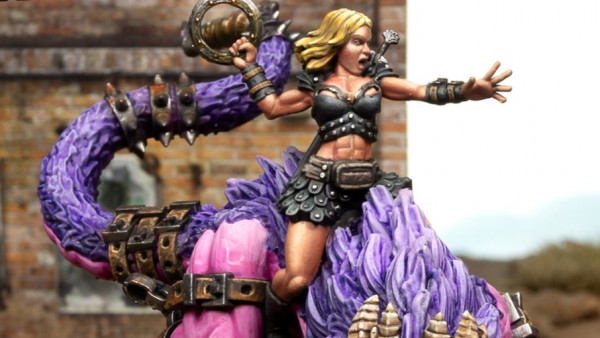
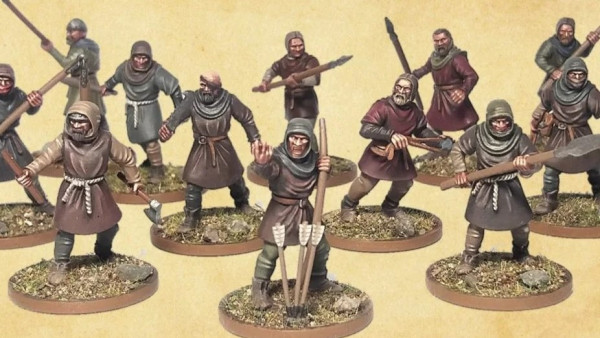




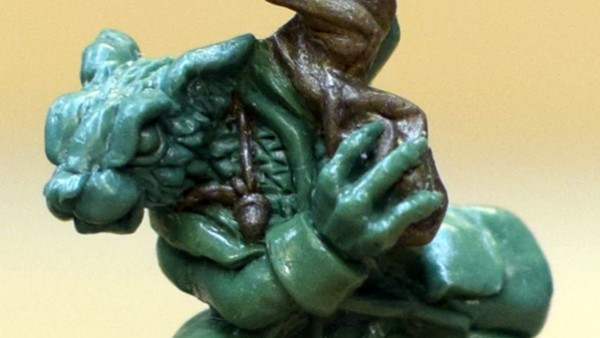


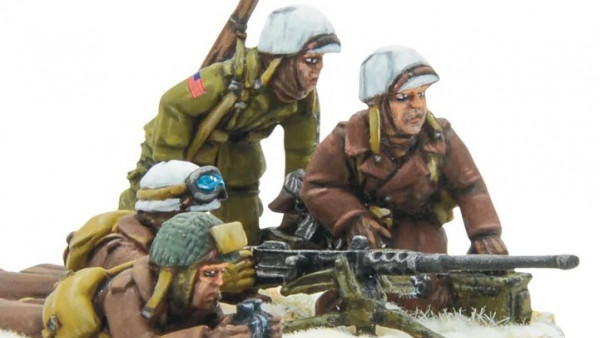




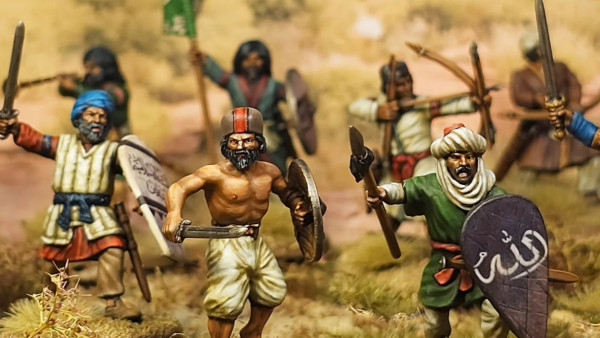


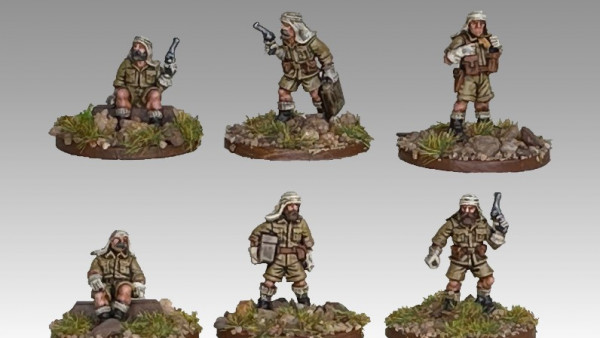



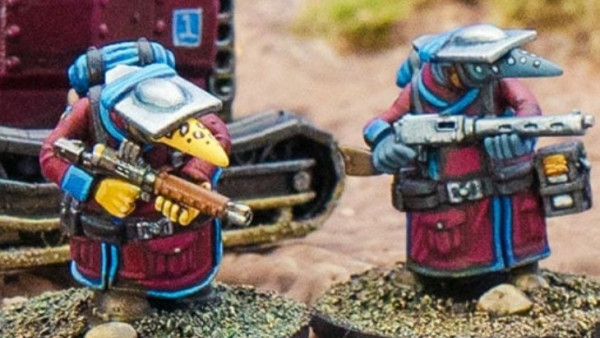
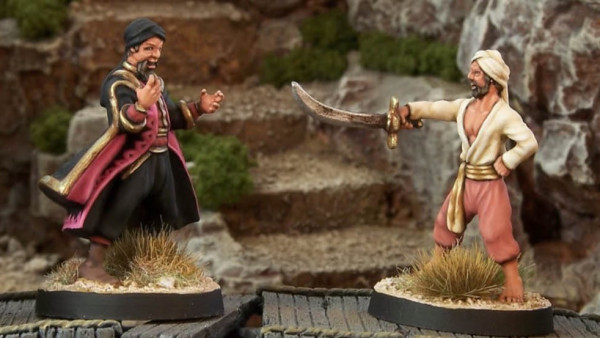



I was tossing and turning late last night in bed going over the many mistakes I made in this one. I should never have got so close to the planet or the Russian plasma.
I might try and write up Captain Rashid getting a dressing down from the higher ups for losing so many ships after seeing Damon’s inspiring example.
I won’t lie, @muakhah, there were some mistakes in this one, but please don’t dwell on them. I think a big part of Darkstar’s replayability is it’s unforgiving nature. It often rewards brilliant play much LESS often than it PUNISHES even the slightest error. This may see harsh, but I feel this brings back players even after a stinging loss because they’re aware that they didn’t just get UNLUCKY or get BEAT by a “better” player … it was something THEY did and they can resolutely correct next time around. Also, it’s a pretty detailed game, and @rasmus is an… Read more »
Thanks @Oriskany. Don’t worry, I only ever lose sleep due to the very best games I play! It shows that Darkstar is an engaging game that holds our attention hours or even days later.
Cool deal, @muakhah. Lord knows I’ve lost sleep over this game over the years. In fact, I’m losing some now. Off to bed! *zzzzz* 😀
It is a great game as @muakhah say or else we would not be back for more and more …
😀 😀 😀 Thanks @rasmus!
That was a bloody knife fight – Plasma based Destroyers at that range will make a mess of anything, and then add the start cutting the shields down at a crucial turn it was going to be a mess.
My first game I lost my flagship to space debris after that I been paranoid of a repeat
The two Sovnyas been named “Levyy Topor” and “Pravyy Topor” by my best google Russian, as they seem to work as a matched pair, it is Left and Right hatchet.
I’ll get around to naming the commanders and the rest of the battle group
Epic names, @rasmus – I will update the battlegroup campaign sheet. 😀
And we might go for the Krasnoi (Krasny) for the Novgorod that did not show up until after the battle – the K-56s who care about the numbers on them 😉
Cool deal. I will make additional updates. 😀